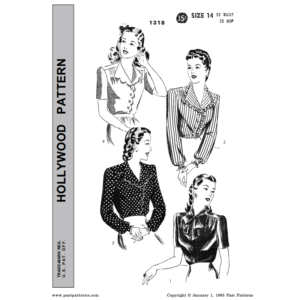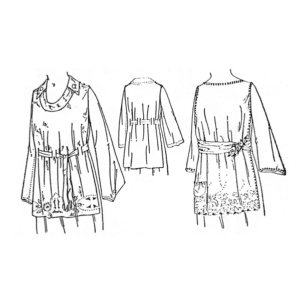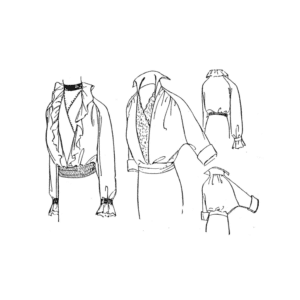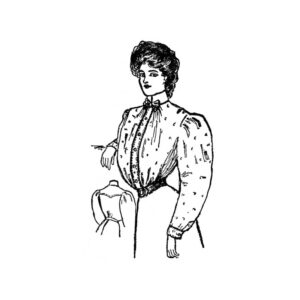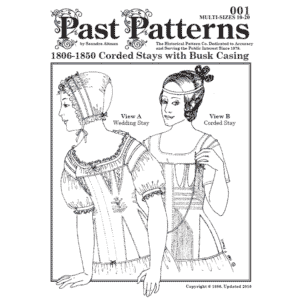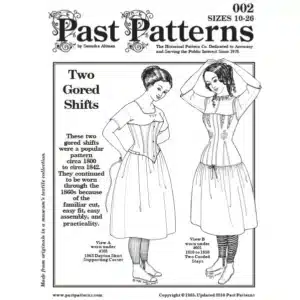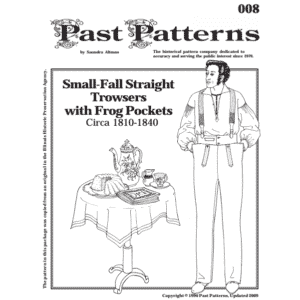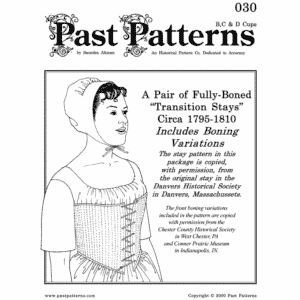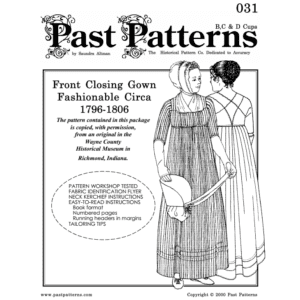Mid 1910s Tucked Waist Sewing Pattern bust 38 b38 New Idea Pattern Co reproduction
$17.00
Circa 1915
Size: 38” bust
There are 7 pieces in this pattern set.
3/8″ is allowed on all seams and finishing edges, except where noted on pattern
Get Free Shipping
On all US Orders over $50!
Mid 1910s Tucked Waist Sewing Pattern bust 38 b38 New Idea Pattern Co reproduction
$17.00
Circa 1915
Size: 38” bust
There are 7 pieces in this pattern set.
3/8″ is allowed on all seams and finishing edges, except where noted on pattern
Get Free Shipping
On all US Orders over $50!
All of our patterns tell a story.
Why Choose This Pattern?
This Mid 1910s Tucked Waist sewing pattern was originally published by The New Idea Pattern Company
★ ★ ★ ★ ★ ★ ★ ★
We date this pattern to Dec 1918
On the original packaging, the garment was described as a "Ladies' Tucked Waist. With square yoke at back, extending over front, and one-seam sleeves in full-length with turn-back cuffs. Front closing."
A query of ChatGPT in June 2024 yields, "The 'Ladies' Tucked Waist' from 1918 was a common style during that era, reflecting the fashion trends of the time. This style typically featured a fitted bodice with delicate tucks or pleats, often creating a subtle texture or gathered effect. The square yoke at the back was a distinctive feature, adding visual interest to the garment.
Women's fashion during the early 20th century often emphasized a tailored silhouette with intricate details such as tucking, pleating, lace, and embroidery. The tucked waist, with its square yoke at the back, would have been a popular choice for both everyday wear and more formal occasions."
★ ★ ★ ★ ★ ★ ★ ★
This Waist pattern was designed to fit the size and shape of a mid 1910s woman with 38” bust. This is the only size we offer for this pattern.
For resizing information, see https://pastpatterns.com/resizing-vintage-patterns/
There are 7 pieces in this pattern set.
3/8" is allowed on all seams and finishing edges, except where noted on pattern
★ ★ ★ ★ ★ ★ ★ ★
Materials Required
2 1/8 Yds 36” Wide
Saundra Altman, our founder, suggested, "Mid 1910s Tucked Waists similar to this were made of Lace, chiffon, crepe de Chine, French crepe, voile, wash silk or linen and they were colored cream, black, white, navy, gray, flesh, pink, bisque, blue, brown, maize, and tan."
ChatGPT, again in June 2024, thought,
"In the late 1910s, ladies' tucked waists were typically made from lightweight and breathable fabrics suitable for the warmer seasons.
Some common fabric choices included Cotton, Lawn, Silk and Voile. Cotton was widely used for everyday wear. It was comfortable, easy to launder, and came in a variety of qualities and finishes.
Lawn fabric, a lightweight plain weave cotton, was popular for its softness and delicate texture. It was often used for summer blouses and dresses. Silk was reserved for more formal occasions or higher-end garments. It added a touch of luxury and was favored for its lustrous appearance. Voile, another lightweight cotton fabric, was sheer and airy, making it ideal for warm weather clothing.
As for colors, the late 1910s saw a range of hues and prints, though there were some notable trends:
Soft, delicate pastel shades such as blush pink, pale blue, lavender, and mint green were popular choices, especially for daytime wear. Neutral colors like ivory, beige, and taupe were also common, offering a timeless and versatile look. Floral prints, small geometric patterns, and dainty stripes were popular choices for adding interest to garments without overwhelming the delicate silhouette of the tucked waist. For more formal occasions, rich jewel tones like deep emerald, sapphire blue, and ruby red were fashionable choices, adding a touch of sophistication to evening wear."
★ ★ ★ ★ ★ ★ ★ ★
The package has a copy of the original artwork on the front cover and a material requirements chart on the back cover. Inside the booklet is a pattern layout chart, brief written directions and historical notes on The New Idea Pattern Company from the era. We also include our Guide to Editing Garments Due to Bust Size . The patterns are on a 36" wide sheet, hand drawn and computer printed, emulating the originals.
★ ★ ★ ★ ★ ★ ★ ★
Our patterns are printed on 20 lb. white paper and packaged in a reusable plastic. We always attempt to offer the most reasonable shipping rates for domestic and international orders. Multi item purchases are automatically adjusted for combined shipping.
★ ★ ★ ★ ★ ★ ★ ★
Past Patterns 2024. All rights reserved.
Additional information
| Weight | 5 oz |
|---|---|
| Dimensions | 13 × 10 × 2 in |
Sizing Information

(Metric size sheet opens as a PDF in a new browser tab)
Preferred Vendors
Past Patterns works with vendors from all over the world to help us replicate the amazing articles of clothing. Now you can too!
Visit our preferred vendors page to order directly from some of our top recommended suppliers.
FAQ's
(Frequently asked questions)
Why are both Trowsers and Trousers listed on site?
Over the last 200 years, much like the human body, our style of language has changed. For vintage patterns, we attempt to use the language of the day where possible.
Can you grade (edit) a Vintage Revival pattern for my size?
please contact us with the specific pattern number and the specifications you require. We have staff available for this for an additional fee.
What sizes do Past Patterns patterns come in?
Our patterns, with some exceptions, are manufactured in sizes 8 through 26 for women and sizes 34 through 54 for men. Most patterns are multi-sized. For a complete listing of measurements in inches see the size chart.
Do you have vintage patterns (manufactured prior to 1950) that you want to sell?
we are always on the lookout for original, American designed, vintage patterns especially for categories outside of current items. We are interested if you have 1 pattern or 1000 patterns. Give us a call to discuss.
Why is my pattern size different from my off the rack dress size?
We use the U. S. Board of Standard Measurements to size our patterns. The ready made clothing manufacturers have their own set of sizes developed from their own statistics. For a complete listing of measurements in inches see the size chart.
How are the patterns packaged?
We package our patterns in two forms: Bond Paper and Tissue. Except for the Tissue patterns, each is slipped into a reusable plastic sleeve. Many contain documentation in the form of Historical Notes or the printer ie., Butterick. Because the patterns are printed in house to order, they can take from three to seven days. Tissue patterns, which are printed out of house, are available to ship immediately.
What does a Corset Kit contain in addition to the Corset pattern?
In addition to the pattern, the kits contain everything you need to make the corset except the thread. The kits contain, according to their type, fabric and lining, stays, clasp or busk board, back lacing, tape for finishing the edges, trim lace, ribbon, leather, tin stock, waist tape, punch and setter, eyelets, marking pencils, cording, reed and a loop turner.
Need a pattern in your language?
we can translate our instructions into just about any language
Have an old and incomplete Past Patterns item. What can I do?
The answer depends on if the pattern is still in production or not. If it is, please mail us the old pattern and we will ship you a copy of the latest pattern for a minimal fee along with normal shipping charges. If the item is no longer in production, we would need to know exactly what you have to determine the best course of action to help you.
What is the difference between a Past Patterns original pattern and a Vintage Revival pattern?
The Past Patterns originals were designed in house and based upon the research, disassembly and time of Saundra Ros Altman. These designs come from finds all over the United States reaching from San Diego, California to the Smithsonian Museum in Washington, DC. She created the initial patterns, the sizing charts and the instruction content. Many of the these patterns are multi-sized or are available in various sizes. For the most part, these designs are done taking into account the modern human body's shape, height and weight. The Vintage Revival patterns are traces or copies of an old, mass produced pattern; the first mass produced patterns came out in the 1850s. For the most part, you get exactly what came in the original package; in some cases, Saundra has appended historical notes to the instructions. The Vintage Revivals patterns, being copies of the originals, generally only come in one size and are based upon the size and shape of the human body from the era the pattern came from.
What software do you use to create patterns?
We utilize PW Studio for our designs. Isabelle Lott, a contributor over the years to Past Patterns, is the owner of the company and will be happy to answer an software related questions you have. Her software is available for licensing.
What measurements do I need to know to order a Corset Kit?
The bust and back length. The back length is measured from the prominent bone at the base of the neck to the natural waistline.
Where can I see the appropriate clothing fabrics for the 18th and 19th centuries?
You can see 1740 through 1940 fabrics in a book titled "Textile Designs" by Susan Meller and Joost Elffers. The subtitle states, "Two Hundred Years of European and American Patterns for Printed Fabric by Motif, Style, Color, Layout and Period and 1,823 Illustration in Color." What they don't say is that 90% of the swatches pictured are life size. The ISBN is 0-8109-3853-7. A second book is Wearable Prints, 1740-1860, History, Materials, and Mechanics by Susan W. Greene. The ISBN is 978-1-60635-124-6. Great books! Order it from your local library that has interlibrary loan capability if you cannot afford the price. There are now many sources for appropriate fabric through the Internet.
Where can I find antique patterns to purchase?
On the Internet try: "Patterns from the Past."
Need a pattern tomorrow?
we do offer expedited domestic shipping for extra fees. We can also expeditie international shipments but delivery dates overseas cannot be promised.
Becoming a Wholesalers of our patterns
We offer Wholesalers significant discounts that will allow both your and our businesses to flourish.
Why don't we sell PDFs of our patterns - First due to piracy. We have spent over 40 years creating and tracing these patterns along with researching them. We print and ship all of our patterns ourselves. If we started sending out PDFs, in no time, copies of our Intellectual Property would be all over the internet and we would be out of business. Second, some of our patterns are constantly being updated. We want our clients to get the BEST POSSIBLE version of our products.




